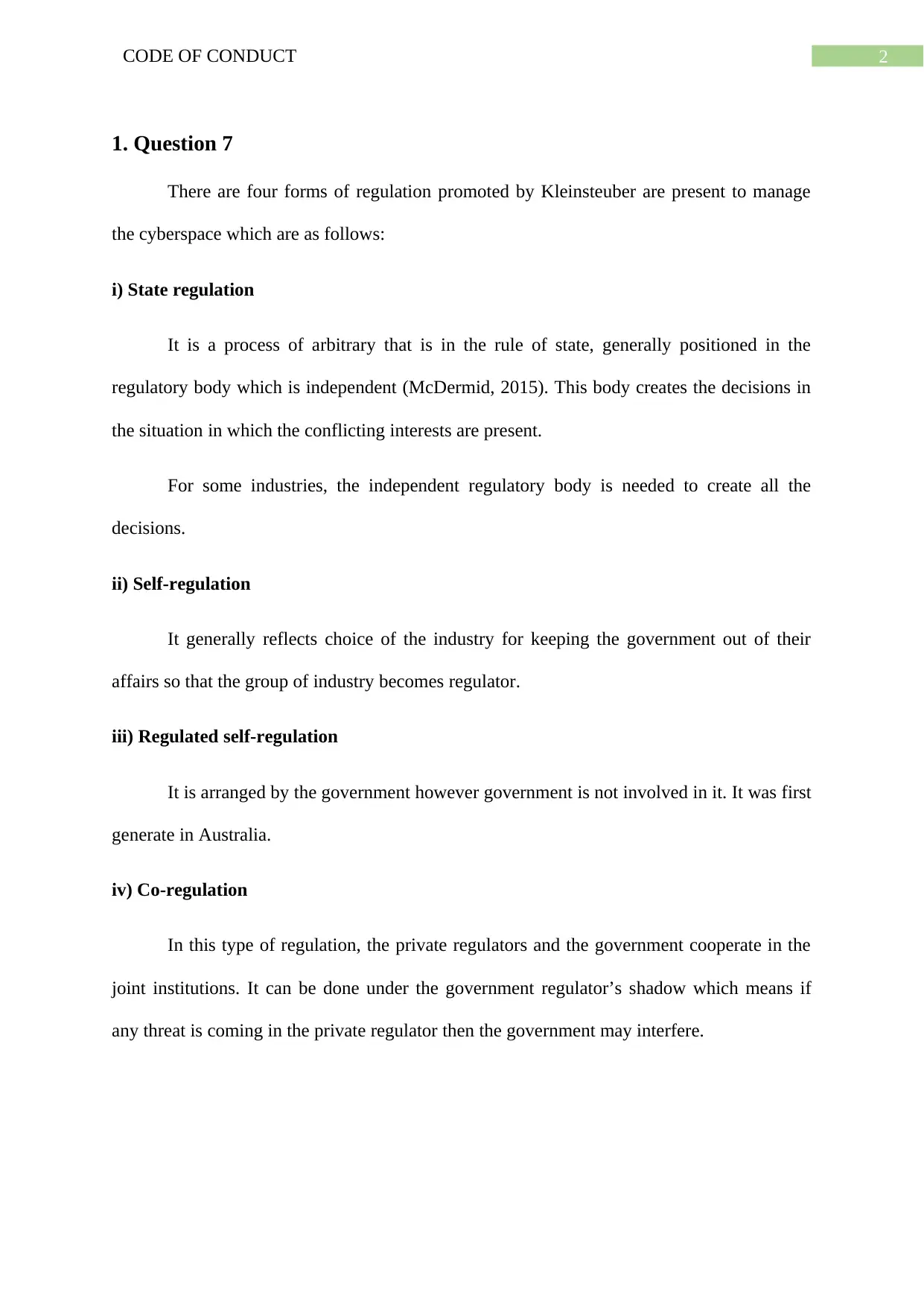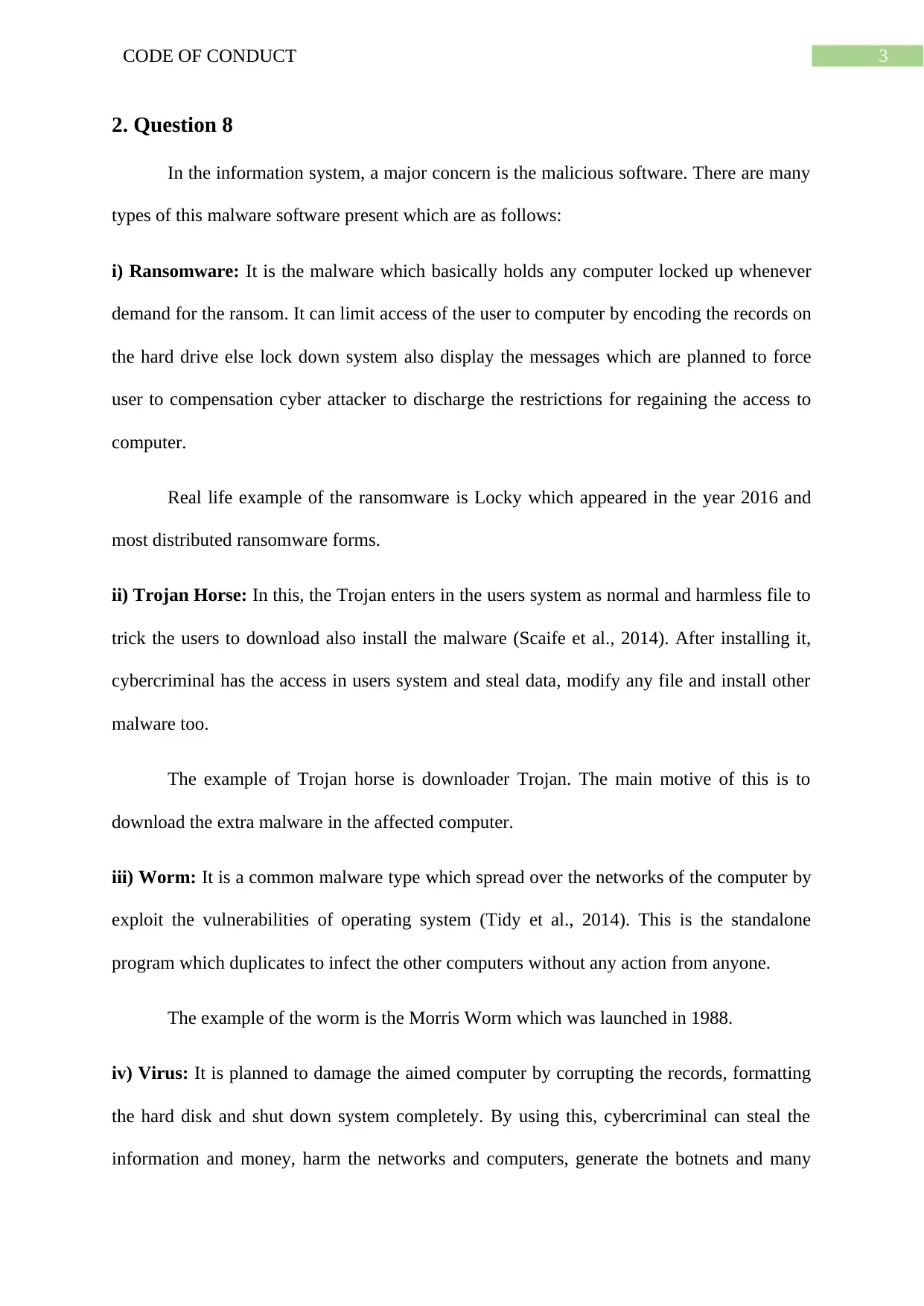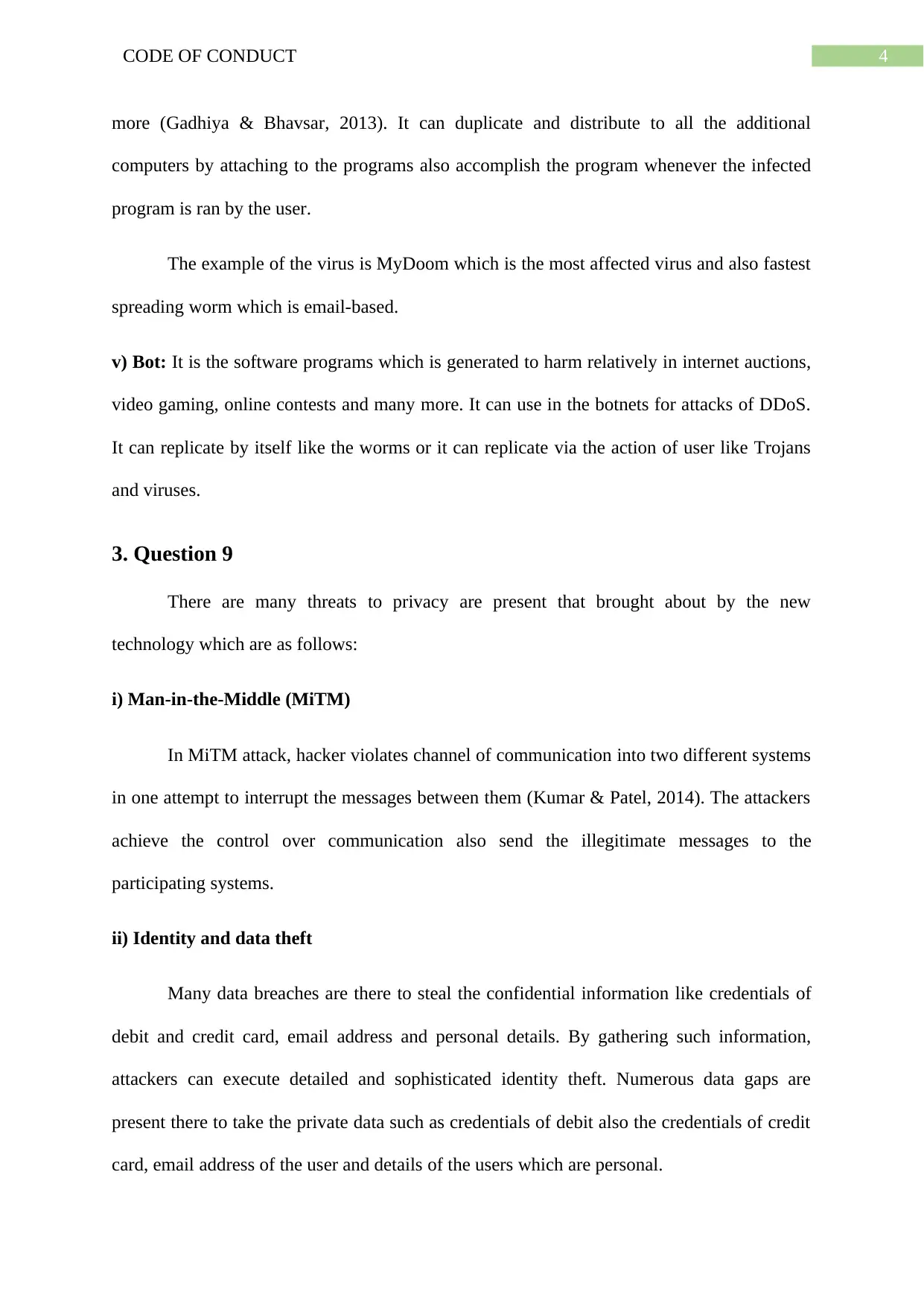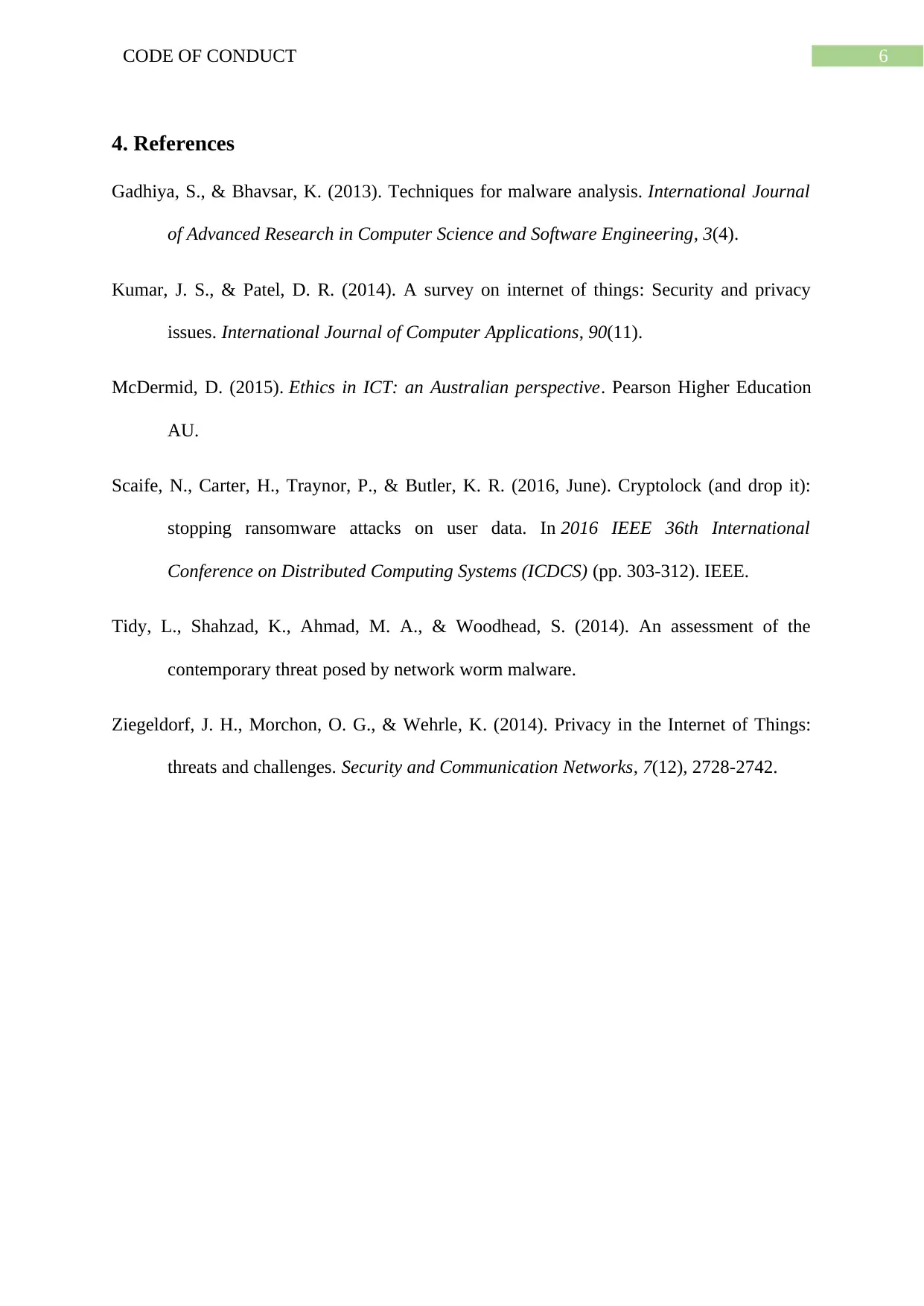Professional Development 300578: Code of Conduct Assignment - Module 1
VerifiedAdded on 2022/09/10
|7
|1173
|25
Homework Assignment
AI Summary
This document is a solution to a professional development assignment focusing on the code of conduct. It addresses three key questions related to ethical considerations in cyberspace. The first question explores different forms of regulation, including state regulation, self-regulation, regulated self-regulation, and co-regulation. The second question delves into the issue of malicious software, detailing various types such as ransomware, Trojan horses, worms, viruses, and bots, providing real-world examples for each. The final question examines threats to privacy brought about by new technologies, including man-in-the-middle attacks, identity and data theft, and social engineering. The assignment adheres to APA referencing style, providing a list of cited references. This solution provides a comprehensive overview of the ethical challenges and security threats within the digital landscape, making it a valuable resource for students studying professional development.

Running head: CODE OF CONDUCT
CODE OF CONDUCT
Enter name of the Student:
Enter name of the University:
Author note:
CODE OF CONDUCT
Enter name of the Student:
Enter name of the University:
Author note:
Paraphrase This Document
Need a fresh take? Get an instant paraphrase of this document with our AI Paraphraser

1CODE OF CONDUCT
Table of Contents
1. Question 7..................................................................................................................2
2. Question 8..................................................................................................................2
3. Question 9..................................................................................................................2
4. References..................................................................................................................2
Table of Contents
1. Question 7..................................................................................................................2
2. Question 8..................................................................................................................2
3. Question 9..................................................................................................................2
4. References..................................................................................................................2

2CODE OF CONDUCT
1. Question 7
There are four forms of regulation promoted by Kleinsteuber are present to manage
the cyberspace which are as follows:
i) State regulation
It is a process of arbitrary that is in the rule of state, generally positioned in the
regulatory body which is independent (McDermid, 2015). This body creates the decisions in
the situation in which the conflicting interests are present.
For some industries, the independent regulatory body is needed to create all the
decisions.
ii) Self-regulation
It generally reflects choice of the industry for keeping the government out of their
affairs so that the group of industry becomes regulator.
iii) Regulated self-regulation
It is arranged by the government however government is not involved in it. It was first
generate in Australia.
iv) Co-regulation
In this type of regulation, the private regulators and the government cooperate in the
joint institutions. It can be done under the government regulator’s shadow which means if
any threat is coming in the private regulator then the government may interfere.
1. Question 7
There are four forms of regulation promoted by Kleinsteuber are present to manage
the cyberspace which are as follows:
i) State regulation
It is a process of arbitrary that is in the rule of state, generally positioned in the
regulatory body which is independent (McDermid, 2015). This body creates the decisions in
the situation in which the conflicting interests are present.
For some industries, the independent regulatory body is needed to create all the
decisions.
ii) Self-regulation
It generally reflects choice of the industry for keeping the government out of their
affairs so that the group of industry becomes regulator.
iii) Regulated self-regulation
It is arranged by the government however government is not involved in it. It was first
generate in Australia.
iv) Co-regulation
In this type of regulation, the private regulators and the government cooperate in the
joint institutions. It can be done under the government regulator’s shadow which means if
any threat is coming in the private regulator then the government may interfere.
⊘ This is a preview!⊘
Do you want full access?
Subscribe today to unlock all pages.

Trusted by 1+ million students worldwide

3CODE OF CONDUCT
2. Question 8
In the information system, a major concern is the malicious software. There are many
types of this malware software present which are as follows:
i) Ransomware: It is the malware which basically holds any computer locked up whenever
demand for the ransom. It can limit access of the user to computer by encoding the records on
the hard drive else lock down system also display the messages which are planned to force
user to compensation cyber attacker to discharge the restrictions for regaining the access to
computer.
Real life example of the ransomware is Locky which appeared in the year 2016 and
most distributed ransomware forms.
ii) Trojan Horse: In this, the Trojan enters in the users system as normal and harmless file to
trick the users to download also install the malware (Scaife et al., 2014). After installing it,
cybercriminal has the access in users system and steal data, modify any file and install other
malware too.
The example of Trojan horse is downloader Trojan. The main motive of this is to
download the extra malware in the affected computer.
iii) Worm: It is a common malware type which spread over the networks of the computer by
exploit the vulnerabilities of operating system (Tidy et al., 2014). This is the standalone
program which duplicates to infect the other computers without any action from anyone.
The example of the worm is the Morris Worm which was launched in 1988.
iv) Virus: It is planned to damage the aimed computer by corrupting the records, formatting
the hard disk and shut down system completely. By using this, cybercriminal can steal the
information and money, harm the networks and computers, generate the botnets and many
2. Question 8
In the information system, a major concern is the malicious software. There are many
types of this malware software present which are as follows:
i) Ransomware: It is the malware which basically holds any computer locked up whenever
demand for the ransom. It can limit access of the user to computer by encoding the records on
the hard drive else lock down system also display the messages which are planned to force
user to compensation cyber attacker to discharge the restrictions for regaining the access to
computer.
Real life example of the ransomware is Locky which appeared in the year 2016 and
most distributed ransomware forms.
ii) Trojan Horse: In this, the Trojan enters in the users system as normal and harmless file to
trick the users to download also install the malware (Scaife et al., 2014). After installing it,
cybercriminal has the access in users system and steal data, modify any file and install other
malware too.
The example of Trojan horse is downloader Trojan. The main motive of this is to
download the extra malware in the affected computer.
iii) Worm: It is a common malware type which spread over the networks of the computer by
exploit the vulnerabilities of operating system (Tidy et al., 2014). This is the standalone
program which duplicates to infect the other computers without any action from anyone.
The example of the worm is the Morris Worm which was launched in 1988.
iv) Virus: It is planned to damage the aimed computer by corrupting the records, formatting
the hard disk and shut down system completely. By using this, cybercriminal can steal the
information and money, harm the networks and computers, generate the botnets and many
Paraphrase This Document
Need a fresh take? Get an instant paraphrase of this document with our AI Paraphraser

4CODE OF CONDUCT
more (Gadhiya & Bhavsar, 2013). It can duplicate and distribute to all the additional
computers by attaching to the programs also accomplish the program whenever the infected
program is ran by the user.
The example of the virus is MyDoom which is the most affected virus and also fastest
spreading worm which is email-based.
v) Bot: It is the software programs which is generated to harm relatively in internet auctions,
video gaming, online contests and many more. It can use in the botnets for attacks of DDoS.
It can replicate by itself like the worms or it can replicate via the action of user like Trojans
and viruses.
3. Question 9
There are many threats to privacy are present that brought about by the new
technology which are as follows:
i) Man-in-the-Middle (MiTM)
In MiTM attack, hacker violates channel of communication into two different systems
in one attempt to interrupt the messages between them (Kumar & Patel, 2014). The attackers
achieve the control over communication also send the illegitimate messages to the
participating systems.
ii) Identity and data theft
Many data breaches are there to steal the confidential information like credentials of
debit and credit card, email address and personal details. By gathering such information,
attackers can execute detailed and sophisticated identity theft. Numerous data gaps are
present there to take the private data such as credentials of debit also the credentials of credit
card, email address of the user and details of the users which are personal.
more (Gadhiya & Bhavsar, 2013). It can duplicate and distribute to all the additional
computers by attaching to the programs also accomplish the program whenever the infected
program is ran by the user.
The example of the virus is MyDoom which is the most affected virus and also fastest
spreading worm which is email-based.
v) Bot: It is the software programs which is generated to harm relatively in internet auctions,
video gaming, online contests and many more. It can use in the botnets for attacks of DDoS.
It can replicate by itself like the worms or it can replicate via the action of user like Trojans
and viruses.
3. Question 9
There are many threats to privacy are present that brought about by the new
technology which are as follows:
i) Man-in-the-Middle (MiTM)
In MiTM attack, hacker violates channel of communication into two different systems
in one attempt to interrupt the messages between them (Kumar & Patel, 2014). The attackers
achieve the control over communication also send the illegitimate messages to the
participating systems.
ii) Identity and data theft
Many data breaches are there to steal the confidential information like credentials of
debit and credit card, email address and personal details. By gathering such information,
attackers can execute detailed and sophisticated identity theft. Numerous data gaps are
present there to take the private data such as credentials of debit also the credentials of credit
card, email address of the user and details of the users which are personal.

5CODE OF CONDUCT
iii) Social engineering
Hackers use this social engineering to manipulate the people for giving up their
confidential information like bank details and passwords (Ziegeldorf, Morchon & Wehrle,
2014). In other hand, cybercriminals can use this social engineering to access the system to
install the malicious software in secret. The cybercriminals can do the cybercrime by using
this social engineering to operate the users to give their all the information which are very
confidential such as the details of the bank and the passwords of their account otherwise the
password of the credit and debit card.
iii) Social engineering
Hackers use this social engineering to manipulate the people for giving up their
confidential information like bank details and passwords (Ziegeldorf, Morchon & Wehrle,
2014). In other hand, cybercriminals can use this social engineering to access the system to
install the malicious software in secret. The cybercriminals can do the cybercrime by using
this social engineering to operate the users to give their all the information which are very
confidential such as the details of the bank and the passwords of their account otherwise the
password of the credit and debit card.
⊘ This is a preview!⊘
Do you want full access?
Subscribe today to unlock all pages.

Trusted by 1+ million students worldwide

6CODE OF CONDUCT
4. References
Gadhiya, S., & Bhavsar, K. (2013). Techniques for malware analysis. International Journal
of Advanced Research in Computer Science and Software Engineering, 3(4).
Kumar, J. S., & Patel, D. R. (2014). A survey on internet of things: Security and privacy
issues. International Journal of Computer Applications, 90(11).
McDermid, D. (2015). Ethics in ICT: an Australian perspective. Pearson Higher Education
AU.
Scaife, N., Carter, H., Traynor, P., & Butler, K. R. (2016, June). Cryptolock (and drop it):
stopping ransomware attacks on user data. In 2016 IEEE 36th International
Conference on Distributed Computing Systems (ICDCS) (pp. 303-312). IEEE.
Tidy, L., Shahzad, K., Ahmad, M. A., & Woodhead, S. (2014). An assessment of the
contemporary threat posed by network worm malware.
Ziegeldorf, J. H., Morchon, O. G., & Wehrle, K. (2014). Privacy in the Internet of Things:
threats and challenges. Security and Communication Networks, 7(12), 2728-2742.
4. References
Gadhiya, S., & Bhavsar, K. (2013). Techniques for malware analysis. International Journal
of Advanced Research in Computer Science and Software Engineering, 3(4).
Kumar, J. S., & Patel, D. R. (2014). A survey on internet of things: Security and privacy
issues. International Journal of Computer Applications, 90(11).
McDermid, D. (2015). Ethics in ICT: an Australian perspective. Pearson Higher Education
AU.
Scaife, N., Carter, H., Traynor, P., & Butler, K. R. (2016, June). Cryptolock (and drop it):
stopping ransomware attacks on user data. In 2016 IEEE 36th International
Conference on Distributed Computing Systems (ICDCS) (pp. 303-312). IEEE.
Tidy, L., Shahzad, K., Ahmad, M. A., & Woodhead, S. (2014). An assessment of the
contemporary threat posed by network worm malware.
Ziegeldorf, J. H., Morchon, O. G., & Wehrle, K. (2014). Privacy in the Internet of Things:
threats and challenges. Security and Communication Networks, 7(12), 2728-2742.
1 out of 7
Related Documents
Your All-in-One AI-Powered Toolkit for Academic Success.
+13062052269
info@desklib.com
Available 24*7 on WhatsApp / Email
![[object Object]](/_next/static/media/star-bottom.7253800d.svg)
Unlock your academic potential
Copyright © 2020–2025 A2Z Services. All Rights Reserved. Developed and managed by ZUCOL.





